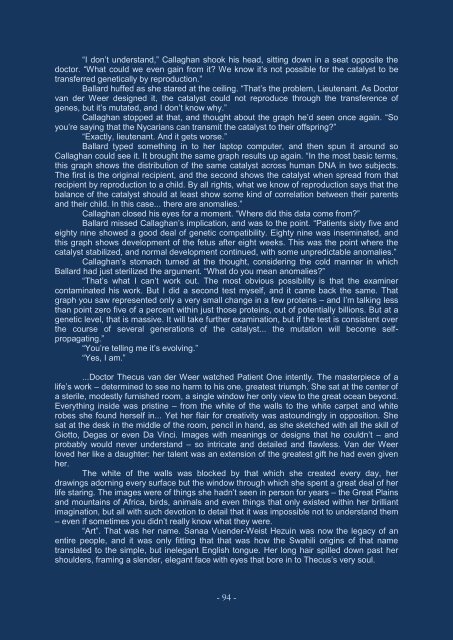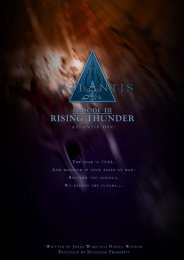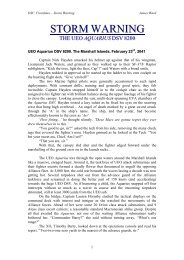CROSSFIRE - Atlantis DSV - New Cape Quest
CROSSFIRE - Atlantis DSV - New Cape Quest
CROSSFIRE - Atlantis DSV - New Cape Quest
You also want an ePaper? Increase the reach of your titles
YUMPU automatically turns print PDFs into web optimized ePapers that Google loves.
“I don‟t understand,” Callaghan shook his head, sitting down in a seat opposite the<br />
doctor. “What could we even gain from it? We know it‟s not possible for the catalyst to be<br />
transferred genetically by reproduction.”<br />
Ballard huffed as she stared at the ceiling. “That‟s the problem, Lieutenant. As Doctor<br />
van der Weer designed it, the catalyst could not reproduce through the transference of<br />
genes, but it‟s mutated, and I don‟t know why.”<br />
Callaghan stopped at that, and thought about the graph he‟d seen once again. “So<br />
you‟re saying that the Nycarians can transmit the catalyst to their offspring?”<br />
“Exactly, lieutenant. And it gets worse.”<br />
Ballard typed something in to her laptop computer, and then spun it around so<br />
Callaghan could see it. It brought the same graph results up again. “In the most basic terms,<br />
this graph shows the distribution of the same catalyst across human DNA in two subjects.<br />
The first is the original recipient, and the second shows the catalyst when spread from that<br />
recipient by reproduction to a child. By all rights, what we know of reproduction says that the<br />
balance of the catalyst should at least show some kind of correlation between their parents<br />
and their child. In this case... there are anomalies.”<br />
Callaghan closed his eyes for a moment. “Where did this data come from?”<br />
Ballard missed Callaghan‟s implication, and was to the point. “Patients sixty five and<br />
eighty nine showed a good deal of genetic compatibility. Eighty nine was inseminated, and<br />
this graph shows development of the fetus after eight weeks. This was the point where the<br />
catalyst stabilized, and normal development continued, with some unpredictable anomalies.”<br />
Callaghan‟s stomach turned at the thought, considering the cold manner in which<br />
Ballard had just sterilized the argument. “What do you mean anomalies?”<br />
“That‟s what I can‟t work out. The most obvious possibility is that the examiner<br />
contaminated his work. But I did a second test myself, and it came back the same. That<br />
graph you saw represented only a very small change in a few proteins – and I‟m talking less<br />
than point zero five of a percent within just those proteins, out of potentially billions. But at a<br />
genetic level, that is massive. It will take further examination, but if the test is consistent over<br />
the course of several generations of the catalyst... the mutation will become selfpropagating.”<br />
“You‟re telling me it‟s evolving.”<br />
“Yes, I am.”<br />
...Doctor Thecus van der Weer watched Patient One intently. The masterpiece of a<br />
life‟s work – determined to see no harm to his one, greatest triumph. She sat at the center of<br />
a sterile, modestly furnished room, a single window her only view to the great ocean beyond.<br />
Everything inside was pristine – from the white of the walls to the white carpet and white<br />
robes she found herself in... Yet her flair for creativity was astoundingly in opposition. She<br />
sat at the desk in the middle of the room, pencil in hand, as she sketched with all the skill of<br />
Giotto, Degas or even Da Vinci. Images with meanings or designs that he couldn‟t – and<br />
probably would never understand – so intricate and detailed and flawless. Van der Weer<br />
loved her like a daughter: her talent was an extension of the greatest gift he had even given<br />
her.<br />
The white of the walls was blocked by that which she created every day, her<br />
drawings adorning every surface but the window through which she spent a great deal of her<br />
life staring. The images were of things she hadn‟t seen in person for years – the Great Plains<br />
and mountains of Africa, birds, animals and even things that only existed within her brilliant<br />
imagination, but all with such devotion to detail that it was impossible not to understand them<br />
– even if sometimes you didn‟t really know what they were.<br />
“Art”. That was her name. Sanaa Vuender-Weist Hezuin was now the legacy of an<br />
entire people, and it was only fitting that that was how the Swahili origins of that name<br />
translated to the simple, but inelegant English tongue. Her long hair spilled down past her<br />
shoulders, framing a slender, elegant face with eyes that bore in to Thecus‟s very soul.<br />
- 94 -





